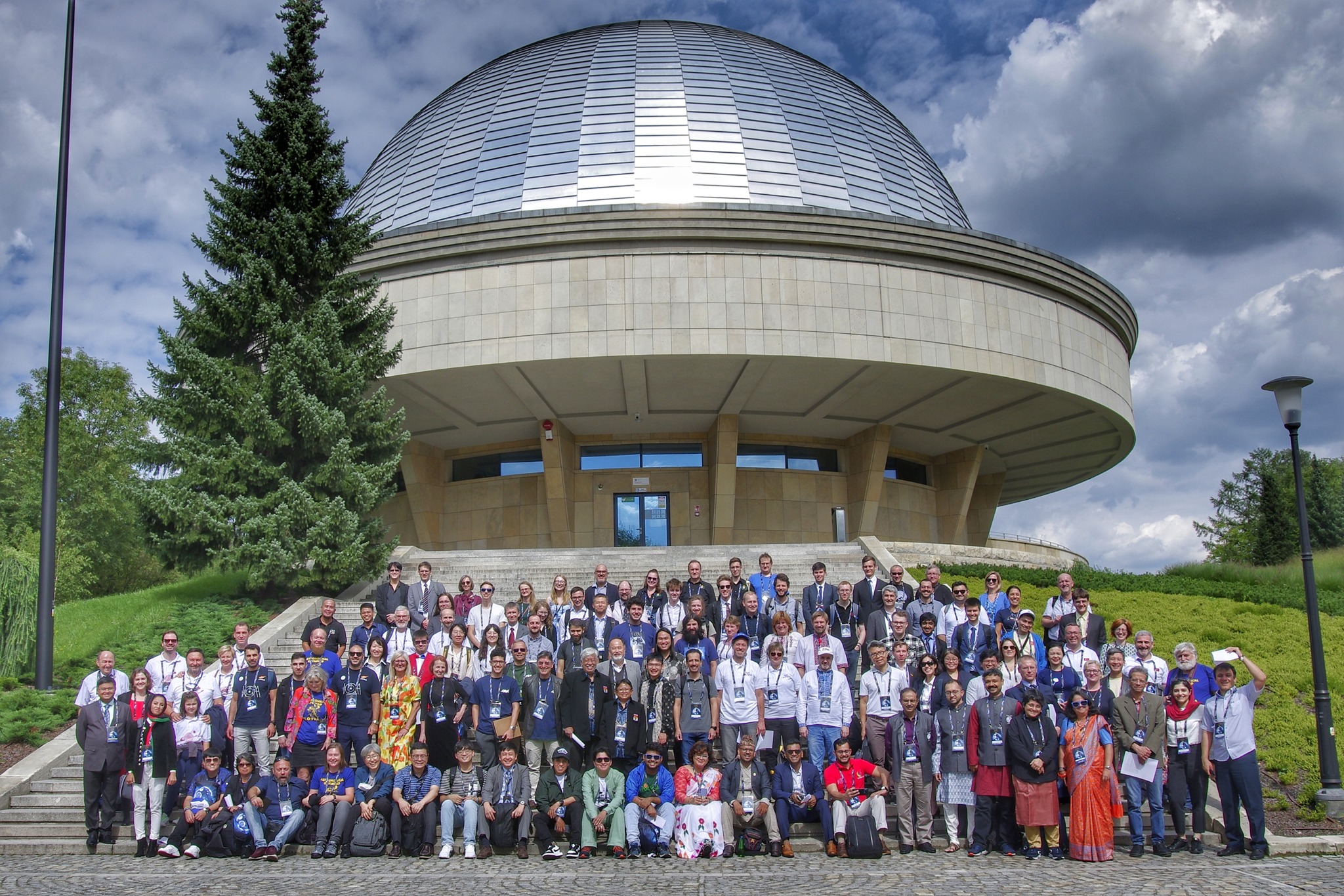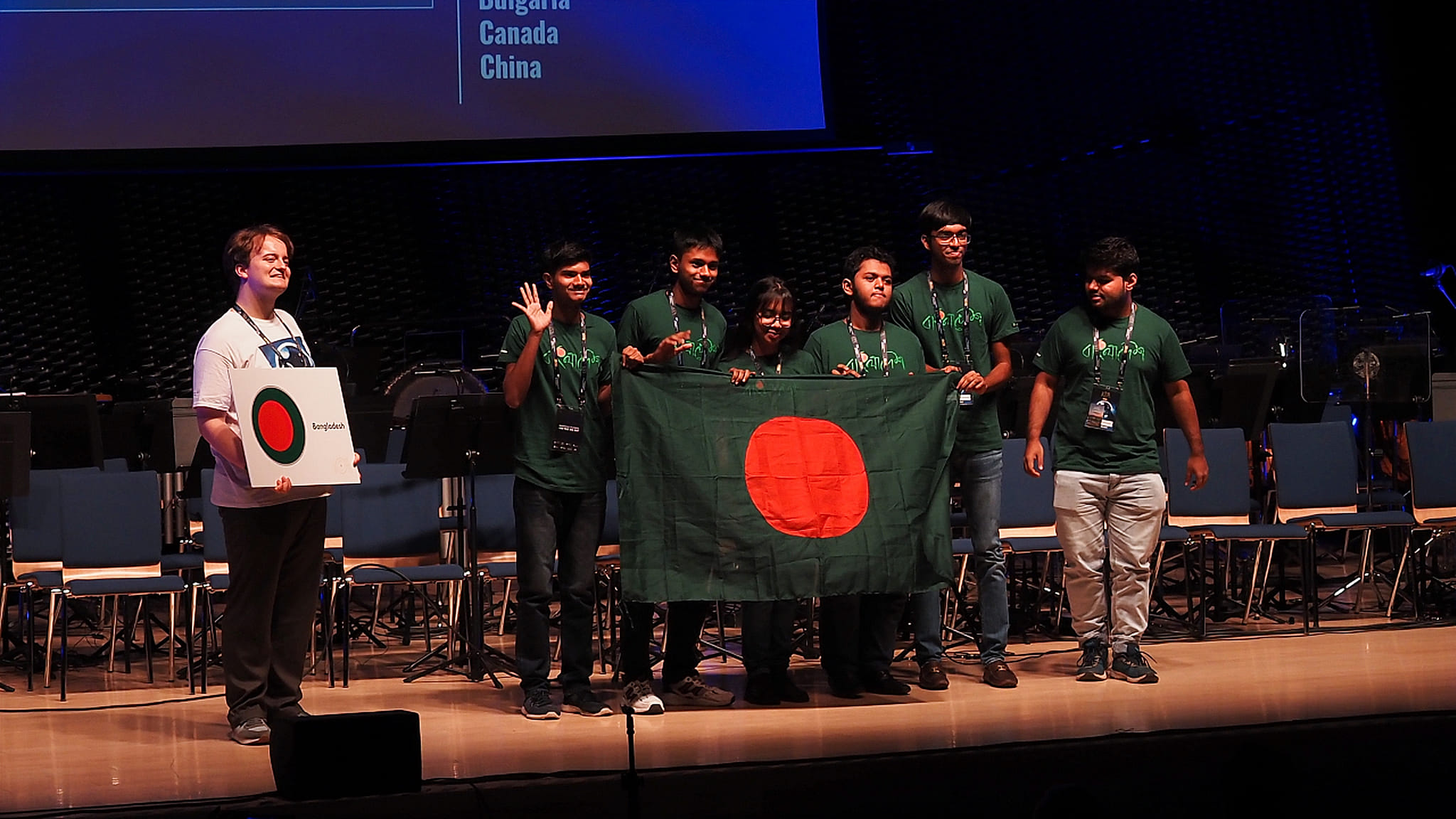
I am an early career researcher. My research interests include Exoplanetary Atmosphere, Strong Gravitational Lensing, Dark Matter distribution, and Variable Stars ✨.
I started my research journey during the summer of 2020. Since then I've worked on several research projects and some Academic projects. I'm working on writing my first research paper, my undergraduate thesis paper, and A Textbook on Astronomy. You can read all about my current endeavors below.

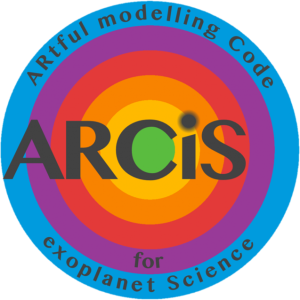
Simulation and Software Skills: ARCiS, LENSTRONOMY, SAOImage DS9, PandExo, TOPCAT, \(\rm LaTex\), Inkscape, Microsoft Word, PowerPoint, Excel.
Programming Languages: C (with high school coursework, 2014-16), \(\rm C++\) (with undergraduate coursework, 2019), \(\rm Python\) (Research projects, 2020-Present), \(\rm HTML/CSS\).
I've written a detailed blog on Astronomy journal reading recommendations and how to read the journals (in Bengali). The blog also contains a list of Bangladeshi Astronomers. Any recommendations for improving the article are welcome. You can read the blog here
\(\text{Research Fellow (April 2024- Present)}\)
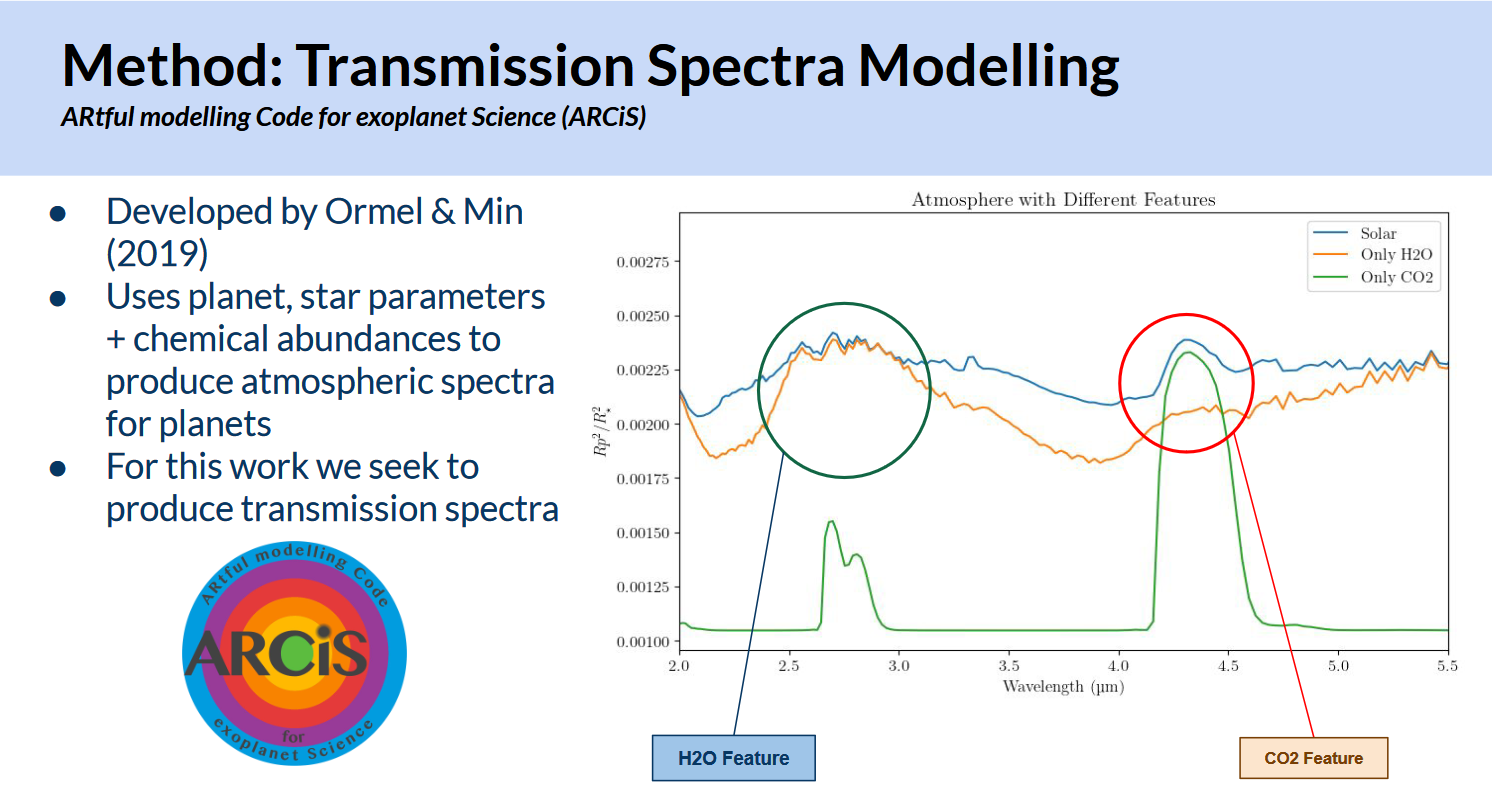
\( \text{keywords: Exoplanetary Atmphsphere} \diamond \text{Forward Modeling \& Retrtieval} \)
I am currently involved in a Research program supervised by Dr. Niloofar Khorshid, an ARIEL postdoctoral fellow from Cosmic Origins, Chalmers University and Technology (CASSUM-CICO-VISO). Under her supervision, we're working on Exoplanetary Atmospheric modeling. In this work, we test the observability of this prediction. We used forward modeling to simulate various planetary atmospheric compositions and investigate whether planets with the same C/O ratio but different metallicities are observable using the James Webb Space Telescope (JWST). We utilized the ARCiS forward modeling and retrieval code in conjunction with PandExo to create models and synthetic observations. We explored the relationship and impact of metallicity (oxygen abundance) and varied the C/O ratio with a defined temperature-pressure profile. Our focus was on the transit spectroscopy of a toy planet, with parameters similar to GJ 486b, in the 2.5 to 5-micron range to observe \(\text{CO}_2\) and \( \text{H}_2\text{O}\) features and mark the changes.
Our forward modeling and initial estimates indicate that the spectra should be distinguishable by JWST, supporting the hypothesis of super-solar oxygen abundance according to IOPF. We aim to perform retrievals to determine the boundary conditions for the C/O ratio, metallicity, and confined/unconfined temperature-pressure profiles to better understand observation feasibility.
\(\text{Research Colloborator (Feb 2023- Present)}\)

\( \text{keywords: Gravitational Lensing} \diamond \text{Bayesian Modeling} \diamond \text{Dark Matter} \)
I am currently involved in a Research program supervised by Dr. Anowar Shajib, a NASA Einstein fellow from the University of Chicago. Under his supervision, we're working on Strong Gravitational Lens modeling. Through lens modeling, we will quantify how the mass is distributed in the lens galaxy and compare it with the light distribution to investigate the alignment between dark matter and baryonic matter in massive elliptical galaxies. The modeling will be performed with the software package lenstronomy, written in Python. I am privileged to be recognized as the first author of the paper that will be submitted for Publication .
From this research I learned the mathematical modeling of stellar systems and got highly involved in Gravitational lenses and Dark matter distribution. I'll soon update this page about the codes used for the program as well as a few notes that I've written to understand the mathematical concepts regarding this research.
TiO and VO in Atmosphere of exoplanet WASP 76-b
\(\text{Summer Intern (May-Aug, 2020)}\)
\( \text{keywords: High resolution Spectroscopy} \diamond \text{WASP 76b} \diamond \text{Extra-terrestial Atmosphere} \)
In the summer of 2020, I had an opportunity to attend my first Astronomy research internship at Leiden University (The Leiden/ESA Astrophysics Program for Summer Students, LEAPS) with Dr. Aurora Kesseli and Dr. Alex Cridland acting as my supervisors on the evolution of the exoplanetary Atmospheres. I have been offered the J. Mayo Scholarship at Leiden Observatory. We looked into the hot Jupiter WASP-76b using High Resolution Spectroscopy (HRS) with the data observed by CARMENES. The method used is transmission spectroscopy. Transmission spectroscopy of exoplanetary atmospheres routinely reveals light chemical species, such as H2O, Na, and K. Heavier molecules, such as Titanium Oxide (TiO) and Vanadium Oxide, have long been predicted to be present in the hottest exoplanetary atmospheres, but definitive detections of these species have been proven to be elusive. It has been predicted that metal oxides such as TiO and Vanadium Oxide occur in the observable regions of the hottest exoplanetary atmospheres causing thermal inversions on the dayside.
Our objective was to compare our observation with the already found signatures of TiO in Low-Resolution Spectroscopy (LRS). Previously, some studies found that there is in fact sign of TiO which was detected using LRS but it was noticed that when we do multi-resolution examination the results sometimes become conflicted and vague. So in our project, we decided to use HRS to confirm the existence of TiO and some other species. Multi-resolution spectroscopic observations are highly valuable in characterizing exoplanetary atmospheres and, hence, in understanding their formation history and evolution.
During our study, we used a cross-correlation method to retrieve any signature of TiO with our predicted model at a certain temperature. Our study at this point found that there are some signs of TiO also H2O but to explain something more vividly we’re cross-checking with different cross-correlation templates and a Python package called SYSREM.
I've written a blog on the basics of Transmission spectroscopy and Exoplanetary atmosphere detection which can be found below. I've also presented my research in the first-ever Bangladeshi Astronomy Journal Club.
জ্যোতির্বিজ্ঞানের যত কিছু -- First Bengali Astronomy Textbook
\(\text{Author (Ongoing)}\)
\( \text{keywords: Introductory Textbook} \diamond \text{Astronomy Olympiads} \diamond \text{Astronomy Outreach} \)
Preview of the Book
Along with my friend Md. Mahmudunnobe, I have dedicated the past five years to the creation of an Astronomy Textbook in Bengali. This academic book primarily targets students preparing for Astronomy Olympiads but extends its reach to early undergraduate students with a passion for Astronomy. The book has been meticulously crafted to provide a highly personalized learning experience, covering topics that are not only relevant to modern astronomy but also incorporate the latest data sets and references in the field. Some very dedicated students (Adnan Bin Alamgir, Md Bayezid Bostami, and Hritom Sarker Oyon) are working as beta-readers and editors to ensure the quality.
The book is written in \(\rm LaTex\) and is currently divided into seven chapters, and we are planning to release it in two volumes. The current draft of the book spans 450 pages, and I have personally curated all the diagrams featured within it. Tamralipi Publications is publishing the first part of the book! Below, I am pleased to provide you with some sample articles and a preview showcasing the diagrams included in the book:
রাতের তারাভরা আকাশ সেই যুগ যুগ ধরেই মানুষকে আকৃষ্ট করে। বর্তমানেও সূর্য-চন্দ্রগ্রহণ, ছায়াপথ, তারার জন্ম-মৃত্যু, কৃষ্ণগহ্বর এইগুলো সবার কাছেই অনেক কৌতুহলের বিষয়। অনেক ক্ষেত্রেই এসবের হালকা কিছু ধারণা নিয়েই আমরা সন্তুষ্ট হয়ে যাই। আবার অনেকসময় আমাদের মনে কিছু প্রশ্ন সাড়া দেয় ঠিকই যার সুন্দর উত্তর খুঁজে পেতে বাগ পেতে হয়। প্রচলিত গল্পকারে লেখা বই পড়ে অনেকেই সন্তুষ্ট হতে পারে না। মহাবিশ্বের এবং আমাদের আকাশের বিভিন্ন চাঞ্চল্যকর বিষয়ের সত্যিকারের সৌন্দর্য্য অনুভব করার জন্য আমাদেরকে এই গল্পগুলোর পেছনের যে গণিত আর বিজ্ঞান আছে, সেটাও জানতে হবে।
এই বইটি তাই তোমাদের জন্যই, যারা মহাকাশের এই গল্পগুলোর সাথে সাথে তার পেছনের গণিত আর বিজ্ঞানটাকেও জানতে চাও। আমরা যখন প্রথম জ্যোতির্বিজ্ঞানের এই মনোমুগ্ধকর জগতে পথচলা শুরু করি, তখন অন্যতম প্রধান একটা বাধা ছিল বাংলায় পর্যাপ্ত রিসোর্সের অভাব। সেই শূণ্যতা পূরণের জন্যই আমাদের এই প্রথম প্রয়াস। বইটি লেখা হয়েছে জ্যোতির্বিজ্ঞান অলিম্পিয়াডকে ভিত্তি ধরে কিন্ত এটি আসলে যেকোনো প্রাথমিক জ্যোতির্বিজ্ঞানে একাডেমিক বইয়ের ভূমিকা পূরন করে। আমরা বিশ্বাস করি বইটি হতে পারে তোমাদের আধুনিক জ্যোতির্বিজ্ঞান গবেষণা এবং চর্চার হাতেখড়ি।
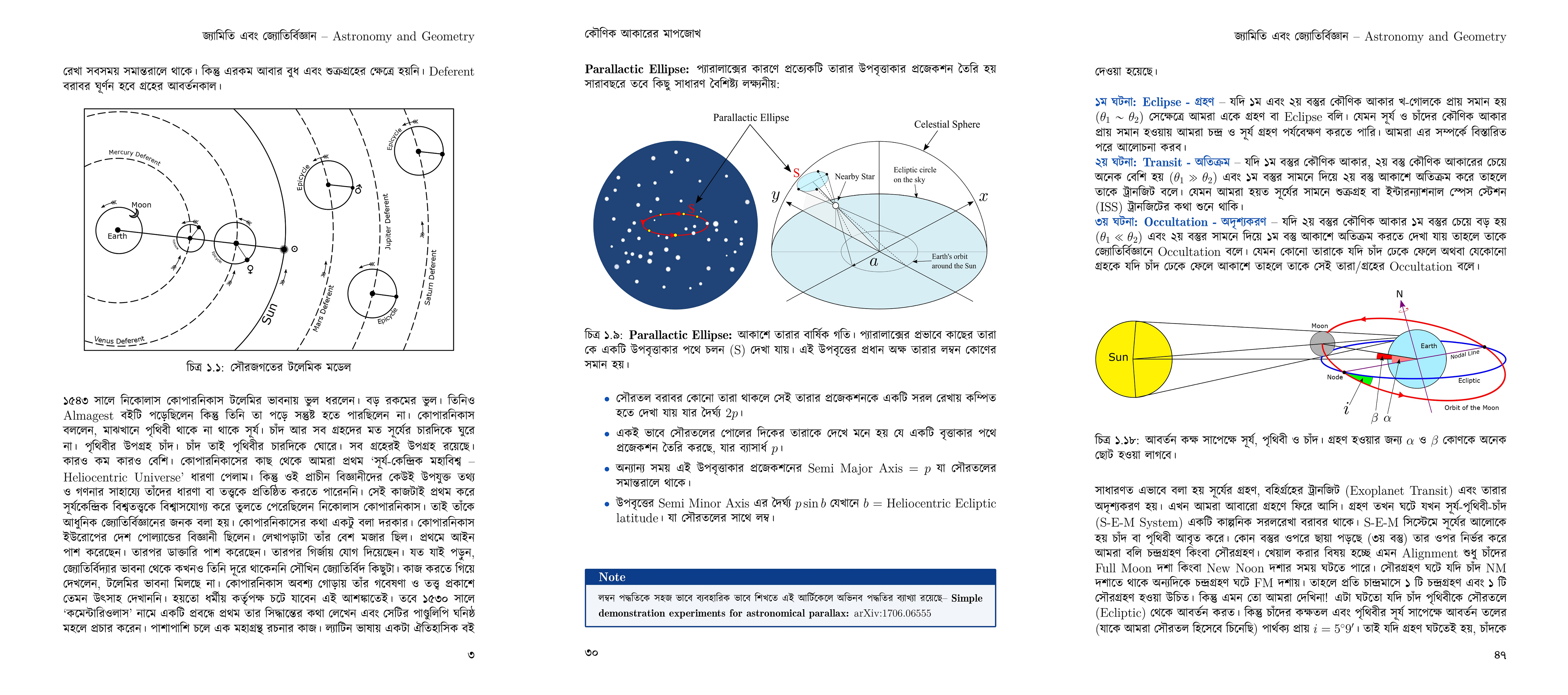
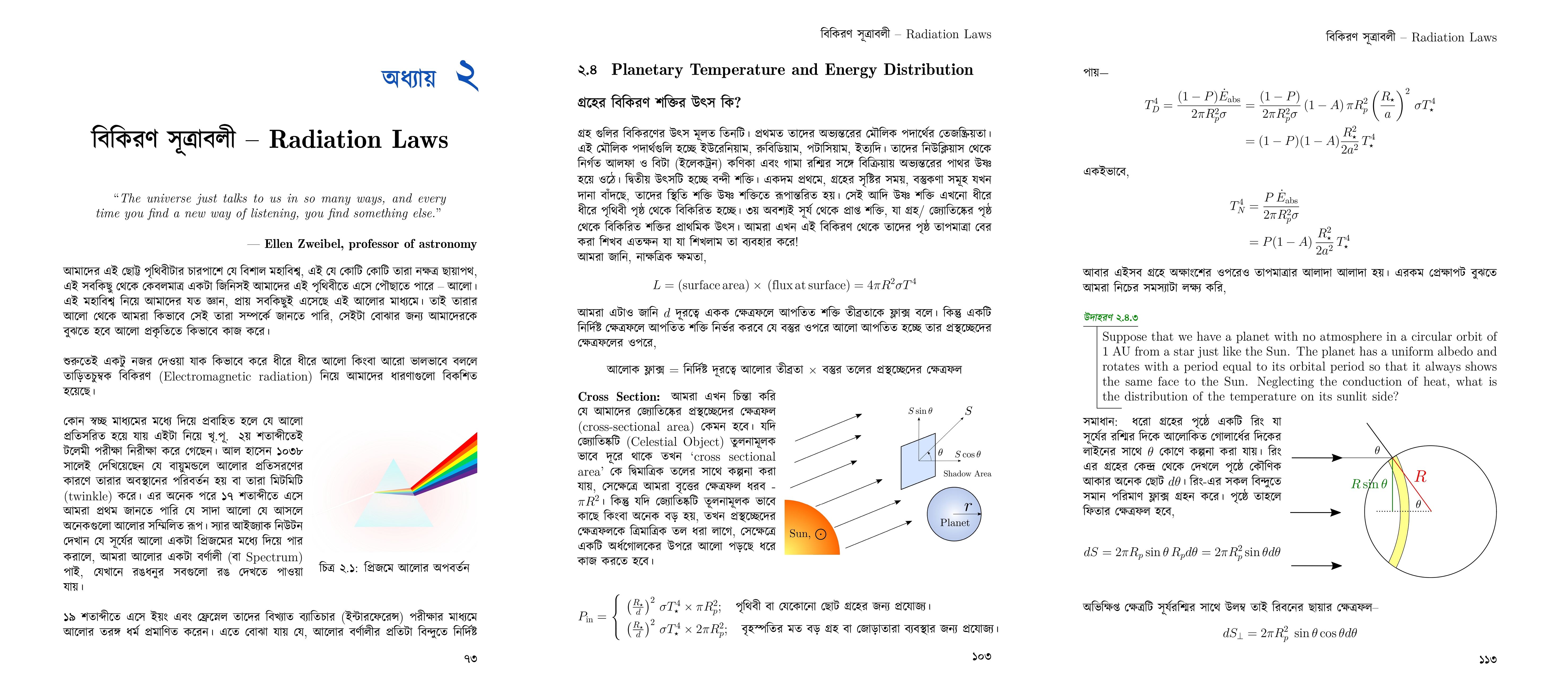
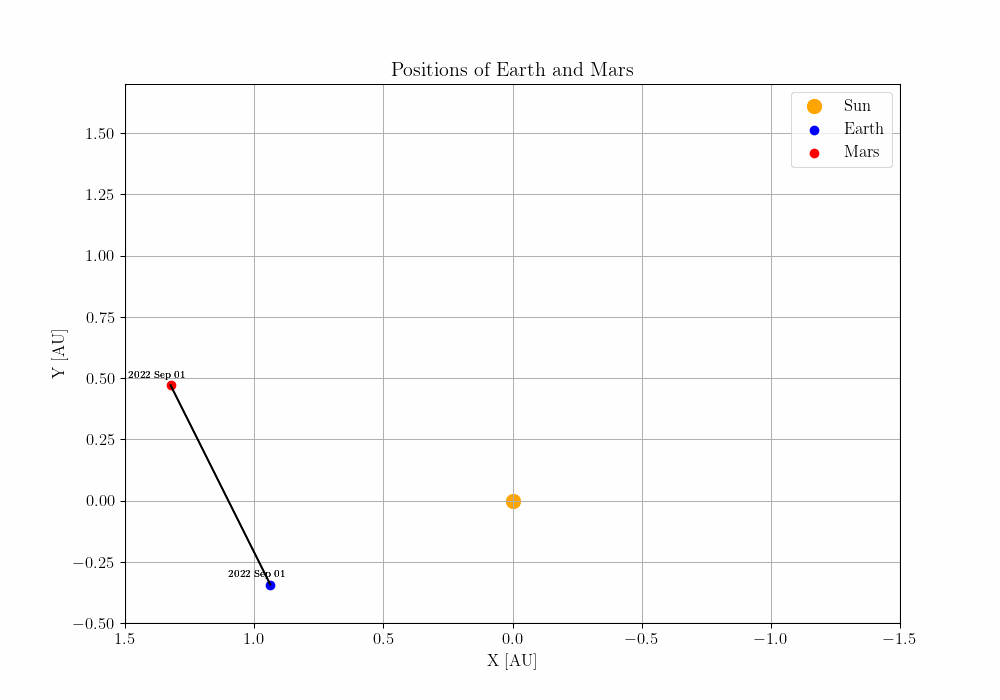
আধুনিক সূর্যসিদ্ধান্ত-- Modern Surya Siddhanta
\(\text{Author (Ongoing)}\)
\( \text{keywords: Historical Astronomy} \diamond \text{Astronomy Olympiads} \diamond \text{Astronomy Outreach} \)
জ্যোতির্বিজ্ঞান নিয়ে এবং পড়াশুনা করছি দীর্ঘদিন যাবত। ২০২০ সাল থেকে একটি বাংলা জ্যোতির্বিজ্ঞান বই নিয়েও কাজ করছি তাই ঘটনাক্রমেই ঘাটতে গিয়ে সূর্য-সিদ্ধান্ত বইয়ের পিডিএফ খুলে বসি। শখের বসে পড়তে গিয়ে দাঁত ভাঙ্গা একেকটা শব্দ আর বিভিন্ন এস্ট্রোনোমিকাল সংজ্ঞার ভারে আমি বুঝছি যে সূর্যসিদ্ধান্ত বর্তমান বাংলাভাষী কেউ পরে কিছু বুঝবেও না আবার আগ্রহ হারিয়ে ফেলবে, কারও আমার মত মাথা খারাপ না। তাই আমি নিজেই নোট আকারে এই বইয়ের আধুনিক অনুবাদ এবং সাথে কিছু আধুনিক টিকা দিয়ে এই কাজটা করা শুরু করেছি। সূর্য সিদ্ধান্তের এই আধুনিক বাংলা এবং ব্যাখ্যা লেখা আমার নিজের কাছে কোনো কোড ডিকোড করার মত লাগছে, আবার আশ্চর্যও লাগছে যে ১০০ বছর আগের অনুবাদ এবং প্রায় কয়েকশ বছর আগেও ভারতীয় উপমহাদেশে জ্যোতির্বিদরা কত কিছু জানত! বাংলাভাষায় এস্ট্রোনমি যে এত কাজ হয়েছে তা কালের গর্বে হারিয়ে যাচ্ছে। আমার প্রথম বই \textit{জ্যোতির্বিজ্ঞানের যত কিছু -- অলিম্পিয়াড ও অন্যান্য} পাবলিশ হওয়ার পর যদি আমার ধৈর্য্য আর আগ্রহ টিকে থাকে তাহলে এই কাজটা বই আকারে পাবলিশ করতে পারি। ততদিন ওপেন-সোর্স পিডিএফ আকারে আগ্রহীদের জন্য আমার নিজস্ব ওয়েবসাইটে রেখে দিচ্ছি, কাজ করার সাথে সাথে আপডেট করব আশা করি।
আধুনিক সূর্যসিদ্ধান্ত PDF








